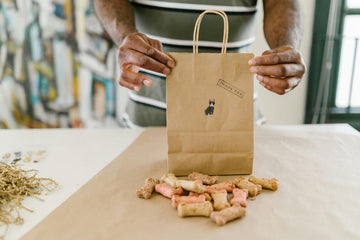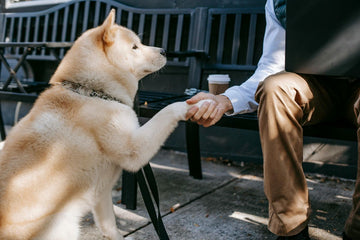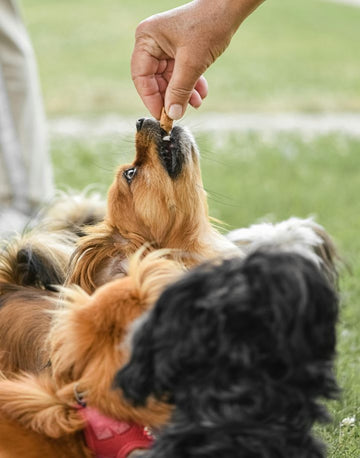Every dog owner knows the delight of discovering a treat their furry companion absolutely adores. Whether your pup goes wild for crunchy biscuits, chewy jerky, or soft training bites, it’s clear that dogs have distinct preferences when it comes to texture. But why do some dogs gravitate toward certain textures while turning their nose up at others? Understanding these preferences can help you select treats that bring your dog happiness while meeting their health needs.
The Role of Texture in a Dog’s Treat Preferences
Texture is a significant factor in how dogs perceive and enjoy food. While taste and smell often steal the spotlight, texture plays a crucial yet overlooked role, shaped by evolution, dental health, and sensory experience.
1. Evolutionary Instincts
Dogs’ ancestors relied on their teeth and jaws to tear through meat or crunch on bones for survival. These primal behaviors have been passed down, influencing modern dogs’ preferences. For instance, crunchy treats may remind your dog of chewing on bones, satisfying their ancestral instincts. Conversely, soft treats might resemble the texture of freshly caught prey, appealing to others.
2. Dental Health and Age
Your dog’s dental health heavily influences their treat choices:
- Puppies with developing teeth often prefer softer treats that are easier to chew.
- Seniors may avoid hard treats if they have sensitive or worn-down teeth.
- Dogs with healthy teeth enjoy crunchy treats for the satisfying break and the added benefit of tartar control.
3. Sensory Experience
A dog’s mouth is filled with nerve endings, making texture an important part of their eating experience.
- Chewy treats offer prolonged satisfaction for dogs who enjoy extended chewing.
- Crunchy treats provide instant gratification, appealing to those who prefer a quick snack.
Some dogs’ preferences also align with their behaviors—if your pup loves gnawing on toys, they might favor hard treats. Meanwhile, dogs who enjoy licking might prefer soft, moist options.
Factors That Shape Your Dog’s Textural Preferences
Beyond instincts and dental health, several other factors shape your dog’s preferences for specific treat textures.
1. Early Exposure
A dog’s upbringing influences their likes and dislikes. Puppies exposed to a variety of textures are more likely to enjoy diverse options as adults. Dogs who grow up eating only one type of texture, however, may be less willing to try something new.
2. Flavor-Texture Combinations
The texture of a treat doesn’t exist in isolation—it works hand in hand with flavor. For example, a crunchy biscuit with peanut butter flavor combines taste and texture in a way some dogs find irresistible. Similarly, a chicken-flavored soft treat might appeal to a different group of pups.
3. Activity Levels and Behavior
Active dogs or working breeds often enjoy chewy or hard treats that take longer to consume, offering both physical and mental stimulation. In contrast, laid-back dogs may prefer softer treats that deliver a quick burst of flavor with minimal effort.
4. Individual Preferences
Dogs, like people, have their own individual likes and dislikes. These can evolve with changes in health, environment, or even mood. Observing your dog’s reactions and offering variety can help you pinpoint their favorite textures.
How to Choose the Right Texture for Your Dog
Picking the perfect treat texture for your pup involves understanding their needs, habits, and preferences. Here are some tips:
1. Consider Their Age
- Puppies: Opt for soft treats or chew sticks designed for young teeth to avoid discomfort.
- Adults: Experiment with a mix of textures to see what they enjoy.
- Seniors: Choose softer treats to accommodate aging teeth and gums.
2. Match Their Chewing Style
Observe your dog’s habits. Do they savor treats by chewing slowly, or do they gulp them down?
- Slow chewers often enjoy harder treats they can gnaw on.
- Fast eaters might prefer softer options that are easy to consume quickly.
3. Keep Dental Health in Mind
If your dog has dental issues, avoid crunchy treats that may cause discomfort. Instead, opt for soft, chewy treats. For dogs with healthy teeth, crunchy treats can support dental hygiene by reducing tartar buildup.
4. Experiment with Variety
Dogs can be surprisingly picky, so don’t hesitate to try different textures. Offering a mix of crunchy, chewy, and soft treats can help you discover what your dog loves most.
5. Pay Attention to Ingredients
Some treats rely on fillers or artificial additives to achieve a certain texture. Always choose treats made with high-quality, natural ingredients to ensure your dog gets the best nutrition possible, regardless of the texture.
Texture and Training: A Perfect Pair
Texture plays an important role during training. Soft treats are typically ideal for training sessions because they’re easy to break into smaller pieces and can be consumed quickly, minimizing distractions. Crunchy treats, while less practical for fast-paced training, can serve as a special reward for more complex tasks or a celebratory treat after a successful session.
Conclusion: Why Texture Matters
Understanding your dog’s preferences for certain treat textures can enhance their happiness and deepen your bond. While some dogs love the satisfying crunch of a biscuit, others might prefer the long-lasting chew of jerky or the tender texture of a soft treat.
By considering factors like age, dental health, and individual behavior, you can select treats that cater to your dog’s unique tastes and needs. And don’t forget to mix things up—variety keeps treat time exciting and rewarding. Whether your pup loves a good crunch or favors a soft nibble, the key is finding the texture that makes their tail wag with joy.





